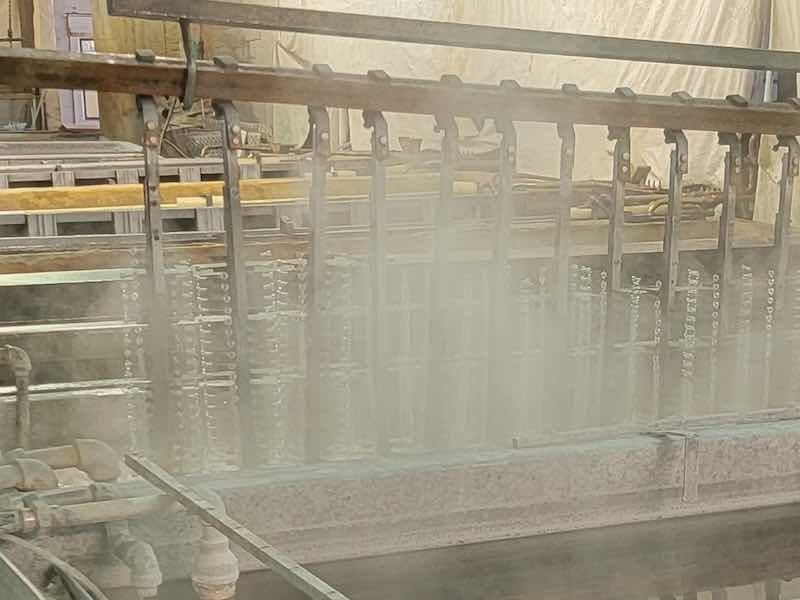The most commonly used materials for anodizing tank cathodes are aluminum, lead (Pb), and stainless steel.
 Larry ChesterfieldThe graphite form of carbon is also a good material for anodizing cathodes but is seldom used. Aluminum has far better electrical conductivity than either lead or stainless steel. Practically speaking, all three metals perform well as cathodes when submerged in an aluminum anodizing electrolyte, such as sulfuric acid, chromic acid, phosphoric acid, and many mixed acid electrolytes.
Larry ChesterfieldThe graphite form of carbon is also a good material for anodizing cathodes but is seldom used. Aluminum has far better electrical conductivity than either lead or stainless steel. Practically speaking, all three metals perform well as cathodes when submerged in an aluminum anodizing electrolyte, such as sulfuric acid, chromic acid, phosphoric acid, and many mixed acid electrolytes.
The Type I anodizing electrolyte is chromic acid, which is non-corrosive to both stainless steel and mild (carbon) steel. The life of either of these materials is nearly indefinite when used as the cathode for this process.
Masking the Inside of the Tank
Because chromic acid is not corrosive to mild steel or stainless steel, the anodizing tank is often used as the cathode. This is done by masking most of the inside of the tank with an insulating material such as polypropylene or other non-conductive material. Leave unmasked the areas of the tank that are to serve as the cathode. Steel or stainless steel cathodes can also be suspended in a poly tank instead of using parts of the tank as the cathodes. See the guidelines for cathode-to-anode ratios below.
For Type II anodizing in dilute sulfuric acid, both 316 stainless steel and aluminum make good cathodes. Many anodizers prefer aluminum because it is a better conductor of electricity than stainless steel. The best commonly available aluminum alloy to use is 6063-T6. It has about 25% better conductivity than 6061-T6. However, there is very little difference in the performance of aluminum (6061-T6 or 6063-T6) vs. stainless steel when used as a cathode.
Aluminum normally has to be replaced every 2 to 4 years, depending on tank anodizing activity, bath concentration, and temperature. Stainless steel may last as long as 10 years. Normally, 5 to 8 years would be the expected life span of stainless steel, depending on the operating conditions.
Cathodes Subjected to the Most Severe Deterioration
The cathodes, no matter what the material, are subject to the most severe deterioration (corrosion) when no anodizing occurs. When anodizing is taking place, the cathodes are “cathodically protected.” Some anodizers want the cathodes to be cathodically protected at all times, so a cathodic trickle charge can be set up to operate when no anodizing is being done in the tank. This will help prolong the life of any metal cathode.
Lead (Pb) is also used as a cathode. It works well, but it does deteriorate very slowly. This sometimes results in low levels of lead in the treated wastewater. This is normally only a problem if there is inadequate wastewater treatment.
The life span of lead as a cathode material can be 10 to 15 years or more. Again, it depends somewhat on the operating conditions in the anodizing tank.
Cathode-to-Anode Ratios
Cathode-to-anode ratios are not rigid standards but are guidelines that can be followed. Here are some recommendations:
- Type I anodizing: Make the cathode no larger than 20% of the average anode surface area. So this would be 1:5, cathode:anode. A ratio as high as 1:10 is often used.
- Type II anodizing: The cathode should be about one half (1/2) of the maximum anode surface area. This would be 1:2, cathode:anode.
- Type III anodizing: Make the cathode between 3/4 and one times the maximum anode area. This would be about 1:1.3, cathode to anode, up to 1:1.
Larry Chesterfield is President and CEO of Anodizing Technologies, Inc. He has experience in a job shop performing anodizing, painting, and fabrication and now offers equipment systems design and build, anodizing technical expertise, and operations/process troubleshooting. Visit anodizingtechnologies.com or email him at larry@anodizingtechnologies.com



































